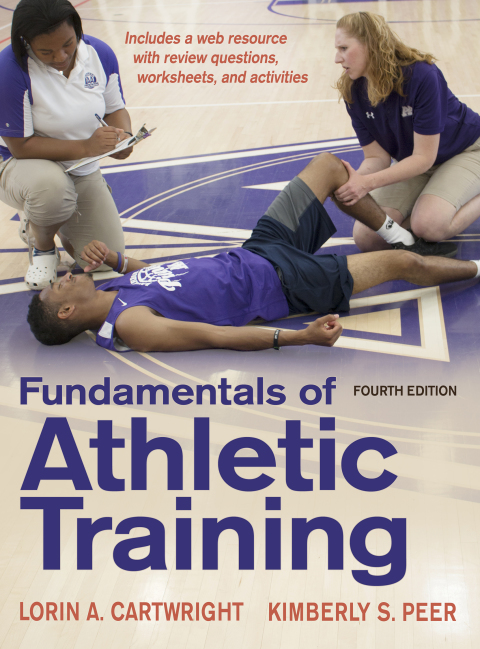Description
Efnisyfirlit
- Cover
- Title Page
- Copyright
- Dedication
- Contents
- List of Anatomical Drawings
- Preface
- Accessing the Web Resource
- Unit I: Professional and Administrative Aspects of Athletic Training
- 1. Athletic Training as a Profession
- Roles of the Athletic Trainer
- The Sports Medicine Team
- Becoming a Certified Athletic Trainer
- Athletic Training Careers
- National Athletic Trainers’ Association
- 2. Administration and Professional Development
- Legal Issues
- Avoiding Legal Problems
- Insurance
- Professional Development and Continuing Education
- The PREMIER Model
- 3. Design and Development of the Athletic Training Facility
- Facility Design and Development
- Safety Factors and Planning Issues
- Maintenance of Facility and Modalities
- Material Safety Data Sheets
- Facility Rules
- 4. Documentation and Record Keeping
- Medical Terminology Basics
- Medical Documentation Notes
- Documentation and Record Keeping
- Patient Confidentiality
- 5. Fiscal Management
- Types of Budgets
- Designing a Budget
- Purchasing
- Inventory Management
- 6. The Preparticipation Physical Exam
- Preparticipation Format and Parts
- Medical Information Forms
- Clearance for Participation in Sport
- Unit II: Basics of Human Anatomy and Physiology
- 7. Introduction to Anatomy
- Anatomical Position
- Body Tissues
- Classification of Joints
- Muscle Movement
- 8. Basics of Tissue Injuries
- Soft-Tissue Injuries
- Bone Injuries
- Unit III: Athletic-Related Injuries to the Head, Spine, and Axial Region
- 9. Head Injuries
- Anatomy of the Head
- Preventing Head Injuries
- Head Injury Mechanisms
- Treating Head Injuries
- 10. Facial Injuries
- Anatomy of the Facial Region
- Preventing Facial Injuries
- Treating Eye Injuries and Conditions
- Treating Ear Injuries
- Treating Nose Injuries
- Treating Mouth Injuries
- 11. Throat and Thorax Injuries
- Anatomy of the Throat
- Anatomy of the Thorax
- Preventing Throat and Thorax Injuries
- Treating Throat Injuries and Conditions
- Treating Thorax Injuries and Conditions
- 12. Abdominal Injuries
- Anatomy of the Abdomen
- Preventing Abdominal Injuries
- Treating Abdominal Injuries and Conditions
- 13. Spinal Injuries
- Anatomy of the Spine
- Postural Considerations
- Preventing Spinal Injuries
- Treating Lumbar Spine Injuries and Conditions
- Treating Cervical Spine Injuries and Conditions
- Unit IV: Athletic-Related Injuries to the Upper Extremity
- 14. Shoulder Injuries
- Anatomy of the Shoulder
- Preventing Shoulder Injuries
- Treating Shoulder Injuries
- Muscle, Bursa, and Tendon Injuries
- Ligament and Joint Injuries
- 15. Elbow Injuries
- Anatomy of the Elbow
- Preventing Elbow Injuries
- Treating Elbow Injuries and Conditions
- 16. Wrist and Hand Injuries
- Anatomy of the Wrist and Hand
- Preventing Wrist and Hand Injuries
- Treating Wrist and Hand Injuries and Conditions
- Unit V: Athletic-Related Injuries to the Lower Extremity
- 17. Hip, Pelvis, and Thigh Injuries
- Anatomy of the Hip, Pelvis, and Thigh
- Preventing Hip, Pelvis, and Thigh Injuries
- Treating Hip, Pelvis, and Thigh Injuries and Conditions
- 18. Knee Injuries
- Anatomy of the Knee
- Preventing Knee Injuries
- Treating Knee Injuries and Conditions
- 19. Foot, Ankle, and Lower-Leg Injuries
- Anatomy of the Foot, Ankle, and Lower Leg
- Preventing Foot, Ankle, and Lower-Leg Injuries
- Treating Foot, Ankle, and Lower-Leg Injuries and Conditions
- Unit VI: Rehabilitation and Reconditioning of Athletic Injuries
- 20. Patient Assessment and Treatment Methods
- Assessing the Athlete and Documenting the Findings
- Phases of Treatment
- Therapeutic Modalities
- 21. Reconditioning Programs
- Strength and Conditioning Principles
- Types of Muscle Actions
- Muscular Development Programs
- Joint Flexibility
- Exercises for Reconditioning Muscles
- Cardiorespiratory Conditioning
- A Word on Safety
- 22. Psychosocial Aspects of Athletic Training
- Referring an Athlete for Professional Help
- Relationship Building
- Practical Suggestions
- Unit VII: Providing Emergency Care
- 23. Planning for Emergencies
- Medical Emergency Cards
- The Crisis Plan
- Practicing the Crisis Plan
- 24. Primary and Secondary Procedures
- Primary Assessment
- Breathing Emergencies
- Cardiopulmonary Emergencies
- Hemorrhage
- Preventing Communicable Disease Transmission
- Secondary Assessment
- HIT
- Specific Conditions
- PRICES Method
- 25. Environmental Situations and Injuries
- Heat-Related Problems
- Cold-Related Problems
- Severe Weather
- Bites and Stings
- 26. Stabilization and Transportation of Injured Athletes
- Equipment Removal
- Lifting and Moving an Athlete
- Unit VIII: Preventing Athletic Injuries
- 27. Protective Taping and Wrapping
- Principles of Taping
- Taping Techniques
- Elastic Wrapping Techniques
- 28. Protective Equipment Used in Athletics
- Protective Equipment for the Head and Face
- Protective Equipment for the Upper Body
- Protective Equipment for the Lower Body
- Unit IX: Other Athletic Conditions and Concerns
- 29. Basic Diagnostic Imaging and Testing
- X-Rays
- Bone Scans
- CT Scans
- MRI
- Ultrasound
- DEXA Scans
- PET Scans
- Blood Testing
- Drug Testing
- 30. Conditions and Illnesses
- Respiratory Conditions
- Vascular Conditions
- Gastrointestinal Conditions
- Diabetes
- Epilepsy
- Arthritis
- Female Athlete Triad
- Rhabdomyolysis
- 31. Communicable Diseases
- Defending Against Microorganisms
- Blood-Borne Conditions
- 32. Common Drugs Used in Athletics
- Therapeutic Drugs
- Recreational Drugs
- Performance-Enhancing Drugs
- Over-the-Counter (OTC) Drugs
- Drug Abuse
- Safety in Distribution of Medications
- Proper Disposal of Medications
- 33. Nutrition and Weight Control
- Major Nutrients
- Healthy Diet
- Understanding Food Nutrition Labels
- Caloric Balance
- Sport Nutrition
- Popular Nutritional Supplements
- 34. Athletes With Disabilities or Disorders
- History of Disabled Sport
- Orthopedic Disabilities
- Auditory and Visual Impairments
- Cardiovascular Disorders
- Transplants
- Neuromuscular Disorders
- Assessing Participation Conditions
- Common Injuries
- Glossary
- Bibliography
- Index
- About the Authors







Reviews
There are no reviews yet.